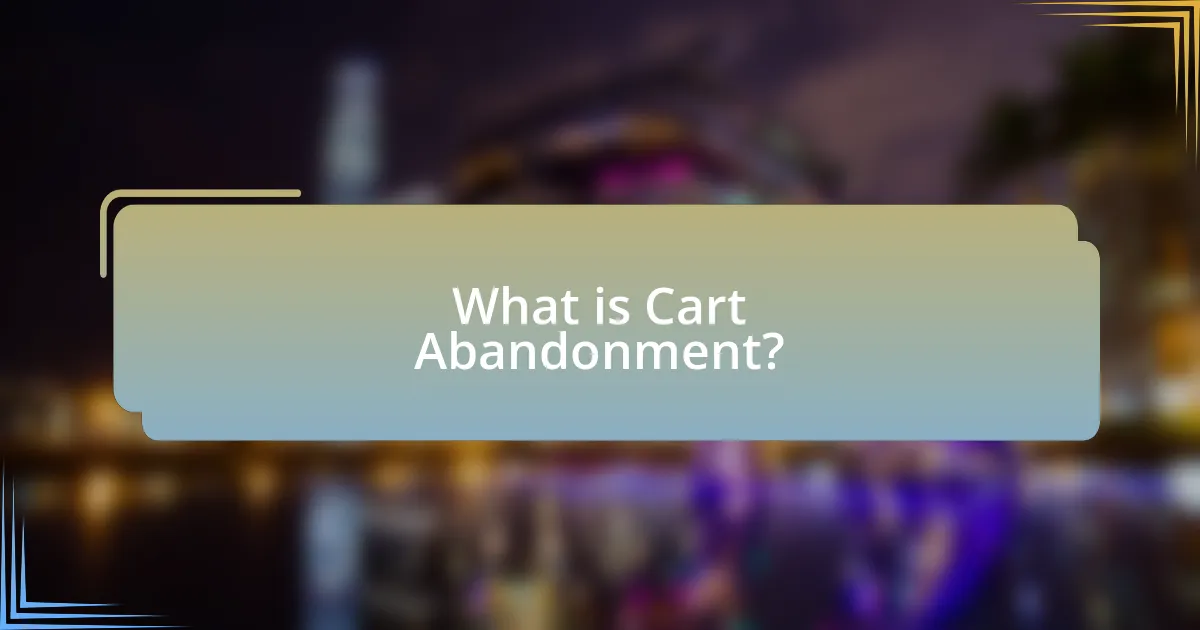Cart abandonment is a prevalent issue in online shopping, where potential customers add items to their carts but fail to complete the purchase, with an average abandonment rate of approximately 69.8%. This article explores the psychological factors influencing cart abandonment, including perceived complexity, fear of commitment, and price anxiety, as well as external distractions that divert attention during the shopping process. It also examines the impact of user experience, website design, and payment options on abandonment rates, alongside industry-specific statistics and trends. Strategies to reduce cart abandonment, such as simplifying checkout processes, offering multiple payment methods, and utilizing personalized marketing techniques, are discussed to enhance conversion rates and improve overall customer satisfaction.

What is Cart Abandonment?
Cart abandonment refers to the phenomenon where potential customers add items to their online shopping cart but leave the website without completing the purchase. According to the Baymard Institute, the average cart abandonment rate across various industries is approximately 69.8%, indicating that a significant number of users do not finalize their transactions after showing initial interest. This behavior can be attributed to various factors, including unexpected costs, complicated checkout processes, or distractions during the shopping experience.
Why do customers abandon their shopping carts?
Customers abandon their shopping carts primarily due to unexpected costs, such as high shipping fees or taxes, which can deter them from completing the purchase. Research indicates that 47% of online shoppers cite extra costs as the main reason for cart abandonment. Additionally, factors like complicated checkout processes, lack of payment options, and concerns about security contribute significantly to this behavior. For instance, a study by the Baymard Institute found that 27% of users abandon their carts due to a lengthy or complicated checkout process. These insights highlight the critical aspects of customer experience that influence cart abandonment rates.
What psychological factors contribute to cart abandonment?
Psychological factors contributing to cart abandonment include perceived complexity, fear of commitment, and price anxiety. Perceived complexity arises when users find the checkout process too complicated or time-consuming, leading to frustration and abandonment. Fear of commitment occurs when customers hesitate to finalize a purchase due to concerns about making the wrong choice or being locked into a decision. Price anxiety is triggered when customers feel uncertain about the total cost, including hidden fees or shipping charges, which can deter them from completing the transaction. Research indicates that 69.57% of online shopping carts are abandoned, highlighting the significant impact of these psychological factors on consumer behavior.
How do external distractions influence cart abandonment rates?
External distractions significantly increase cart abandonment rates by diverting a shopper’s attention away from the purchasing process. Research indicates that 69.57% of online shopping carts are abandoned, often due to interruptions such as notifications from mobile devices, social media alerts, or environmental factors like noise. These distractions can lead to a loss of focus, causing potential buyers to leave the site before completing their transactions. A study by Baymard Institute highlights that 18% of users abandon their carts due to being distracted by other tasks or notifications, underscoring the impact of external stimuli on consumer behavior during online shopping.
What are the statistics surrounding cart abandonment?
Cart abandonment rates are significant, with an average of 69.8% of online shopping carts being abandoned according to the Baymard Institute’s research. This statistic indicates that nearly seven out of ten potential customers leave their carts without completing a purchase. Factors contributing to this high rate include unexpected costs, complicated checkout processes, and the need for account creation, which were cited by 55% of users as reasons for abandoning their carts. Additionally, mobile users experience higher abandonment rates, with 85% of mobile carts being left behind, highlighting the challenges of mobile shopping.
How do different industries compare in cart abandonment rates?
Different industries exhibit varying cart abandonment rates, with e-commerce generally experiencing higher rates compared to sectors like travel and retail. For instance, the average cart abandonment rate in e-commerce is approximately 69.57%, while the travel industry sees rates around 81%. In contrast, the retail sector has a lower average abandonment rate of about 54%. These differences can be attributed to factors such as user experience, pricing transparency, and the complexity of the purchasing process, which vary significantly across industries.
What trends have emerged in cart abandonment over recent years?
Cart abandonment rates have shown a consistent upward trend in recent years, with an average rate of approximately 70% across various industries. This increase can be attributed to several factors, including the rise of mobile shopping, where users often add items to their carts but do not complete purchases due to distractions or usability issues. Additionally, the prevalence of unexpected costs, such as shipping fees, has been identified as a significant deterrent, with 45% of consumers citing this as a reason for abandoning their carts. Furthermore, the growing emphasis on personalized shopping experiences has led to higher expectations from consumers; when these expectations are not met, abandonment rates tend to rise.

How does User Experience Affect Cart Abandonment?
User experience significantly affects cart abandonment rates by influencing customer satisfaction and decision-making during the online shopping process. A poor user experience, characterized by slow loading times, complicated navigation, or unclear checkout processes, can lead to frustration, prompting customers to abandon their carts. Research indicates that 69.57% of online shopping carts are abandoned, with 27% of users citing a complicated checkout process as a primary reason for abandonment. Therefore, enhancing user experience through streamlined interfaces and efficient checkout procedures can reduce cart abandonment and improve conversion rates.
What role does website design play in cart abandonment?
Website design significantly influences cart abandonment rates by affecting user experience and navigation ease. A poorly designed website can lead to confusion, frustration, and ultimately, the decision to abandon the cart. For instance, research indicates that 70% of online shoppers abandon their carts, often due to complicated checkout processes or unclear calls to action. Additionally, elements such as slow loading times, unresponsive design, and lack of trust signals can deter customers from completing their purchases. Therefore, effective website design that prioritizes user-friendly interfaces and streamlined checkout processes can reduce cart abandonment and enhance conversion rates.
How can navigation issues lead to cart abandonment?
Navigation issues can lead to cart abandonment by creating frustration and confusion for users, which ultimately discourages them from completing their purchases. When customers encounter difficulties in finding products, accessing their shopping cart, or understanding the checkout process, they are more likely to leave the site without finalizing their transaction. Research indicates that 38% of users will stop engaging with a website if the layout is unattractive or confusing, highlighting the critical role of intuitive navigation in retaining customers. Therefore, poor navigation directly impacts user experience and increases the likelihood of cart abandonment.
What impact does page load speed have on user behavior?
Page load speed significantly impacts user behavior, as slower loading times lead to increased bounce rates and decreased user engagement. Research indicates that a one-second delay in page load time can result in a 7% reduction in conversions, highlighting the critical nature of speed in retaining users. Additionally, studies show that 40% of users abandon a website that takes more than three seconds to load, demonstrating a direct correlation between load speed and user retention. Therefore, optimizing page load speed is essential for enhancing user experience and minimizing cart abandonment.
How do payment options influence cart abandonment?
Payment options significantly influence cart abandonment by affecting consumer trust and convenience during the checkout process. Research indicates that 18% of consumers abandon their carts due to a lack of preferred payment methods, highlighting the importance of offering diverse options. Additionally, when consumers encounter unexpected fees or complicated payment processes, their likelihood of abandoning the cart increases. A study by the Baymard Institute found that 7% of users abandon their carts because they feel the payment process is too complicated. Therefore, providing a variety of secure and user-friendly payment options can reduce cart abandonment rates by enhancing the overall shopping experience and building consumer confidence.
What are the most common payment-related frustrations for users?
The most common payment-related frustrations for users include unexpected costs, complicated checkout processes, and lack of payment options. Users often abandon their carts when they encounter hidden fees, such as shipping or taxes, which can increase the total cost significantly. Research indicates that 61% of users abandon their carts due to unexpected costs, highlighting the importance of transparency in pricing. Additionally, a complicated checkout process, which may involve multiple steps or excessive information requirements, can lead to frustration and abandonment; studies show that 27% of users cite this as a reason for not completing their purchase. Lastly, limited payment options can deter users, as 56% of consumers prefer to use their preferred payment method, and if it is not available, they may choose to abandon the transaction.
How can offering multiple payment methods reduce abandonment rates?
Offering multiple payment methods can significantly reduce abandonment rates by accommodating diverse customer preferences and increasing convenience. When customers encounter a payment option that aligns with their preferred method, they are more likely to complete their purchase. Research indicates that 18% of online shoppers abandon their carts due to limited payment options, highlighting the importance of flexibility in payment methods. By providing various options such as credit cards, digital wallets, and buy-now-pay-later services, businesses can cater to a wider audience, thereby enhancing the likelihood of transaction completion and reducing cart abandonment.

What Strategies Can Reduce Cart Abandonment?
To reduce cart abandonment, implementing strategies such as simplifying the checkout process, offering free shipping, and sending cart abandonment emails can be effective. Simplifying the checkout process minimizes friction, as studies show that 21% of customers abandon carts due to a complicated checkout. Offering free shipping addresses a primary concern, with 49% of consumers citing it as a reason for abandoning their carts. Sending follow-up emails can recover lost sales, as research indicates that 45% of cart abandonment emails are opened, leading to potential conversions.
How can personalized marketing help decrease cart abandonment?
Personalized marketing can significantly decrease cart abandonment by tailoring the shopping experience to individual customer preferences and behaviors. When retailers utilize data-driven insights to send personalized reminders, offers, or recommendations, they create a sense of relevance and urgency that encourages customers to complete their purchases. For instance, a study by Barilliance found that personalized emails can increase conversion rates by up to 29%, demonstrating that targeted communication effectively prompts customers to return to their abandoned carts. Additionally, personalized marketing strategies, such as dynamic retargeting ads that showcase items left in the cart, can remind customers of their interests and incentivize them to finalize their transactions.
What are effective ways to use retargeting ads?
Effective ways to use retargeting ads include segmenting audiences based on their behavior, personalizing ad content, and timing the ads strategically. Segmenting allows marketers to target users who have shown interest in specific products, increasing relevance and engagement. Personalizing ad content, such as displaying items left in the cart or similar products, enhances the likelihood of conversion. Timing is crucial; showing ads shortly after abandonment can capture attention while the intent is still fresh. According to a study by AdRoll, retargeting ads can lead to a 10x increase in click-through rates compared to standard display ads, demonstrating their effectiveness in re-engaging potential customers.
How can email reminders be optimized for better engagement?
Email reminders can be optimized for better engagement by personalizing content, timing, and frequency based on user behavior. Personalization increases relevance; for instance, including the recipient’s name and specific items left in the cart can enhance connection and prompt action. Timing is crucial; sending reminders shortly after abandonment, ideally within the first hour, can significantly increase open rates and conversions, as studies show that 69% of cart abandoners are likely to return if contacted promptly. Additionally, frequency should be balanced; sending one to three reminders is effective, as excessive emails can lead to disengagement. These strategies are supported by research indicating that personalized and timely communications lead to higher engagement rates in email marketing campaigns.
What best practices should be implemented to improve checkout processes?
To improve checkout processes, businesses should implement a streamlined, user-friendly interface that minimizes friction. This includes reducing the number of steps required to complete a purchase, offering guest checkout options, and providing clear progress indicators throughout the process. Research indicates that 21% of customers abandon their carts due to a lengthy checkout process, highlighting the importance of efficiency. Additionally, integrating multiple payment options can cater to diverse customer preferences, further reducing abandonment rates. A study by the Baymard Institute found that 18% of users abandon carts due to a lack of payment options, reinforcing the need for flexibility in payment methods.
How can simplifying the checkout process reduce abandonment?
Simplifying the checkout process can significantly reduce abandonment by minimizing friction and enhancing user experience. A streamlined checkout reduces the number of steps required to complete a purchase, which directly correlates with higher conversion rates. Research indicates that 21% of online shoppers abandon their carts due to a complicated checkout process, highlighting the importance of simplicity. By implementing features such as guest checkout options, auto-fill for address fields, and clear progress indicators, retailers can create a more efficient and user-friendly experience, ultimately leading to lower abandonment rates.
What role does trust and security play in the checkout experience?
Trust and security are critical components of the checkout experience, as they directly influence a customer’s decision to complete a purchase. When customers perceive a secure environment, they are more likely to share sensitive information, such as credit card details, which is essential for transaction completion. Research indicates that 17% of online shoppers abandon their carts due to concerns about payment security (Baymard Institute, 2023). Additionally, visible security features, such as SSL certificates and trust badges, enhance consumer confidence, reducing anxiety and increasing the likelihood of conversion. Thus, establishing trust and ensuring security are vital for minimizing cart abandonment and fostering successful transactions.
What practical tips can businesses implement to minimize cart abandonment?
To minimize cart abandonment, businesses should implement strategies such as simplifying the checkout process, offering multiple payment options, and providing clear shipping information. Simplifying the checkout process reduces friction, as studies show that 21% of customers abandon carts due to a complicated checkout. Offering multiple payment options caters to diverse customer preferences, which can increase conversion rates. Additionally, providing clear shipping information, including costs and delivery times, addresses a common concern; 44% of shoppers abandon carts due to unexpected shipping costs. These practical tips directly address the psychological barriers that lead to cart abandonment, enhancing the overall shopping experience.





